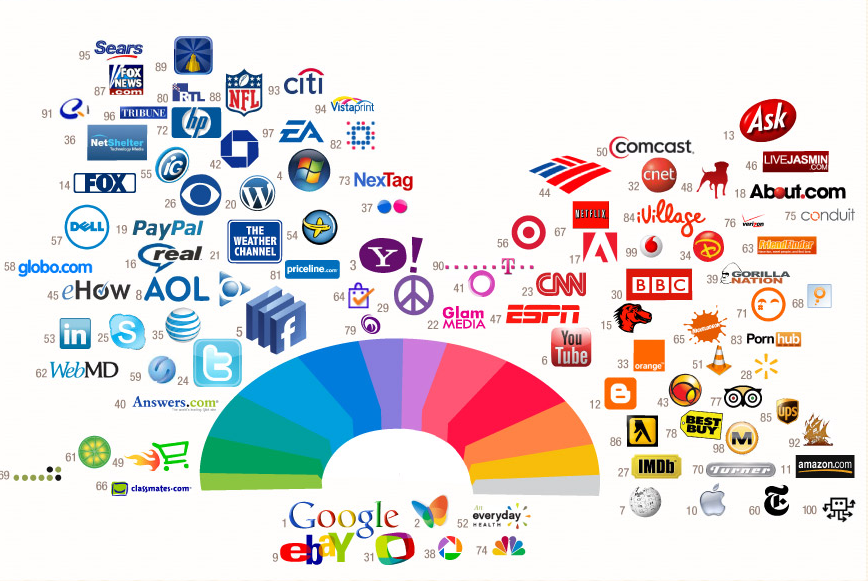Brand Colors – Which Colors are Best for You?
Choosing the right brand colors is crucial for your business. 93% of consumers make purchase decisions based on the color and visual appearance of a brand. Because personal preferences, experiences, and sexual and cultural diversity have a strong influence on individual color likes and dislikes, some companies feel the easiest way to choose colors for their brand is to decide based on the owner’s favorites. This may or may not be true. If the owner represents your brand’s core target audience, choosing his or her favorite colors may be a perfect fit; however, the majority of the time this isn’t the case. Let’s take a look at why color palettes matter and how different colors bring different emotions to consumers.
Male and Female Color Preferences
Based on a recent survey performed by Kissmetrics:
- 57% of men and 35% of women said their most favorite color is blue.
- 27% of men said their least favorite color is brown, while 33% of women said their least favorite color is orange.
- 26% of all participants said they considered orange to be a “cheap” color.
- Women gravitate towards soft colors, while men tend to like bright colors.
- Men prefer simple color names like purple, whereas women use specific color names like plum, eggplant, grape, and orchid to describe the different shades.
Of course, most companies have a mix of male and female consumers, which leads us to have to explore the overall psychology behind brand colors and the emotions they normally cause.
The Psychology of Colors
Black
The color black represents power, elegance, and authority. It’s often associated with intelligence, but it’s also associated with evil and grieving. It’s a serious color that evokes strong emotions.
Common associations with black include authority, class, distinction, formality, mystery, secrecy, seriousness, elegance, and tradition. Black is used by “high-end” brands as the main color or can be paired with another color. Black is somber, serious. Most logos are actually designed in black & white first because color logos also needs to look well for black and white printing.
 |  |  |  |  |
Brown
The color brown represents nature and utility and is often used in logos related to construction and law due to its simplicity, warmth, and neutrality. Brown is seen as being stable, reliable, and approachable, but can also be viewed as boring or dull. In logo design, the color can be used as a subsitute for black, providing an extra bit of warmth black doesn’t portray.
 |  |  |  |  |
Blue
The color blue represents trustworthiness, loyalty, and dependability. The color is very popular with financial institutions and social media platforms due to its message of stability and trust. Blue is also a frequent color used in logos promoting products related to cleanliness, air, and water. Restaurants tend to avoid blue in their logos because it is said that the color suppresses appetite. Blue is the preferred color of men and is the most popular corporate color for brands.
 |  |  |  |  |
Yellow
The color yellow is represents positivity, happiness, and warmth. It gets a person’s attention (which explains why taxis are yellow) but can also represent caution (think yield-signs and traffic lights). Men usually view yellow as a lighthearted and childish color, so you don’t see it very often in expensive product advertising for car manufacturers or men’s clothing stores. Yellow is also viewed as being spontaneous and unstable.
Yellow can sometimes be too bright a color to stand on its own and requires a secondary outline, background or bordering color for balance.
 |  |  |  |  |
Red
The color red is the color of blood, fire, and strength, so it’s often associated with energy, war, danger, and power. However, the color can also represent passion, desire, and love. It’s an emotionally intense color, has very high visibility, and is often used to grab viewers’ attention (think red tag clearance sales and “buy now” buttons). Red has also been known to raise people’s blood pressure and stimulate appetite, so it’s frequently used by food industry brands like Nabisco, Kellogg’s, Frito Lay, Heinz, McDonald’s, and Chick-fil-A.
 |  |  |  |  |
Pink
Pink is a feminine color that conjures feelings of innocence and delicateness. However, bright and vibrant shades of pink often evoke a bold and modern appeal. Overall, pink is known for its friendly and light-heartedness.
Common associations with pink include gratitude, romance, gentleness, innocence, softness, and appreciation.
 |  |  |  |  |
Green
The color green represents nature or finance. It symbolizes growth, freshness, serenity, and healing. It also has a strong emotional connection to safety and balance. Dark green is closely related to money, banking, and wealth. Lighter greens have a calming effect.
Some common associations with green include freshness, harmony, health, eco-friendliness, healing, inexperience, money, and nature. Green means “go.” Used frequently to represent eco-friendly companies and products. Thought to be a calming color.
 |  |  |  |  |
Orange
The color orange is less intense than red but still packs a lot of punch. It represents energy and warmth. Like yellow, orange is also associated with joy, sunshine, and playfulness. You will often find it used in logos to stimulate emotions or even appetites.
Some common associations with orange include creativity, enthusiasm, lightheartedness, affordability, and youth.
 |  |  |  |  |
Purple
The color purple represents royalty, nobility, luxury, and extravagance. It’s a very rare color in nature, and many relate it to creativity and mystery. It is also said to stir up feelings of nostalgia. Once the most expensive color to reproduce (it was made from hard-to-find sea weed), purple is often viewed as “elitist.”
Some common associations with purple include fantasy, mystery, nobility, royalty, and sophistication. Appeals to children and often used in candy and toy packaging.
 |  |  |  |  |
Multi-Colored or “Rainbow” Logos
Multi-colored or “rainbow” logos are a relatively new brand colors phenomenon due to the web and more economical four color printing. They represents brands that are fun, easy-going, or child-like. They are also becoming more popular with brands that are internet, Multi-disciplinary, or Authoritative. These logos also represent a color-branding challenge due to the complex nature, because it is can at times be hard to convert them for black and white use.
 |  |  |  |  |
Still confused about selecting the best color brand colors palette for your brand? Contact Rebel Group today for a free 30-minute consultation to learn how we can help your brand stand out from the competition.

